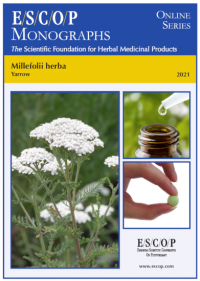Millefolii herba
Yarrow
Achillea millefolium L.
Published 2021
Format: PDF

ESCOP monographs The Scientific Foundation for Herbal Medicinal Products. Online series. Millefolii Herba (Yarrow). Exeter: ESCOP; 2021.
- Download monograph (15 Euro)
- Online viewing (30 Euro por año, gratis para los socios de SEFIT)
SUMMARY
The herbal monograph selects and summarises scientific studies and
textbooks regarding efficacy, dosage, and safety to support the
therapeutic uses of yarrow.
This herbal drug by definition consists of the whole or cut, dried flowering tops of Achillea millefolium L.
Studies with its main characteristic constituents, the essential oil (0.2-5.9%, with α- and β-pinene, 1,8-cineole, sabinene, camphor, borneol, β-caryophyllene and germacrene D as main components), proazulene- and non-azulogenic sesquiterpenes of the guaianolide type, chamazulene carboxylic acid, flavonoids (mainly flavone- and flavonol-O-glycosides) and phenolic acids (mainly dicaffeoylquinic acids) are included.
The therapeutic indications for internal use are loss of appetite, dyspeptic disorders, and the supportive treatment of spasms associated with dysmenorrhea.
The therapeutic indications for external use are the supportive treatment of small wounds, mild inflammations of the skin and mucous membranes, insect repellent activity, and in the form of hip baths for painful pelvic spasms in women.
Administration of yarrow addresses posology; its duration of use; contra-indications; special warnings; special precautions for use; interactions with other medicinal products; other forms of interaction; in pregnancy and lactation; its effects on the ability to drive; undesirable effects and overdose.
In vitro experiments with yarrow demonstrated, antimicrobial, anti-inflammatory, gastrointestinal, radical scavenging, antioxidant, spasmolytic, oestrogenic, antiproliferative, cytotoxic, and cholinesterase inhibiting effects. In vivo experiments with yarrow or its extracts demonstrated anti-inflammatory, spasmolytic, gastroprotective, antidiabetic, and hepatoprotective properties and effects on blood pressure.
Pharmacological studies in humans concern insect repellent activity, as well as skin anti-irritant and anti-aging effects.
Controlled clinical studies with yarrow demonstrated its use in wound healing, for the treatment of chemotherapy-induced oral mucositis, primary dysmenorrhea, chronic kidney disease, and as add-on-therapy in multiple sclerosis.
Preclinical safety data for yarrow were assessed in toxicity studies.
Safety data were assessed in human studies.
The selection of literature cited in the monograph is aimed at bringing together relevant information about the possible physiological roles of yarrow and its major constituents.
KEYWORDS
- Millefolii herba
- Yarrow
- Achillea millefolium L.
- Digestive and dermatological disorders.
- Loss of appetite
- Dyspeptic disorders
- Supportive treatment of spasm associated with dysmenorrhea
- Supportive treatment of small wounds and mild inflammations of the skin and mucous membranes
- Insect repellent activity
Reference: European Scientific Cooperative on Phytotherapy. ESCOP monographs The Scientific Foundation for Herbal Medicinal Products. Online series. Millefolii Herba (Yarrow). Exeter: ESCOP; 2021.
